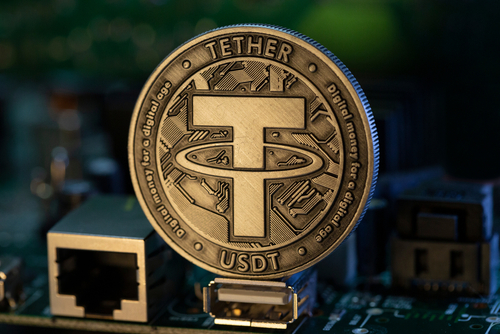

Summary
- We find the reserves of Tether (USDT) are not fully in cash equivalents. There is a sizeable allocation to crypto markets.
- Stablecoin yields are no longer high compared with yields in traditional markets such as dollar currency pegs and money markets.
- With the Fed raising rates, stablecoins could become less attractive.
How Safe Is Tether?
After the TerraUSD/Luna collapse, all eyes have been on whether Tether (USDT) can maintain its peg. And at least over the past week, the answer has been a clear yes. This suggests speculators have moved away from attacking the coin. Nevertheless, the market cap of USDT has fallen by $1bn over the week, suggesting outflows are continuing. In contrast, the USD coin’s (USDC) market cap increased by $0.9bn over the same period. This suggests investors are rotating from USDT to USDC.
This article is only available to Macro Hive subscribers. Sign-up to receive world-class macro analysis with a daily curated newsletter, podcast, original content from award-winning researchers, cross market strategy, equity insights, trade ideas, crypto flow frameworks, academic paper summaries, explanation and analysis of market-moving events, community investor chat room, and more.
Summary
- We find the reserves of Tether (USDT) are not fully in cash equivalents. There is a sizeable allocation to crypto markets.
- Stablecoin yields are no longer high compared with yields in traditional markets such as dollar currency pegs and money markets.
- With the Fed raising rates, stablecoins could become less attractive.
How Safe Is Tether?
After the TerraUSD/Luna collapse, all eyes have been on whether Tether (USDT) can maintain its peg. And at least over the past week, the answer has been a clear yes. This suggests speculators have moved away from attacking the coin. Nevertheless, the market cap of USDT has fallen by $1bn over the week, suggesting outflows are continuing. In contrast, the USD coin’s (USDC) market cap increased by $0.9bn over the same period. This suggests investors are rotating from USDT to USDC.
One reason for the rotation is ongoing concerns about the quality of the collateral used to back USDT. Tether recently released its quarterly assurance report for 2022Q1. It showed Tether had reduced its commercial paper holdings and increased its holding in safe Treasury bills. But not all the reserves are in cash equivalents. Around $12bn of the $82bn of reserves are held in loans, corporate bonds, precious metals and investments in other crypto markets. The latter category – investments in other crypto – has actually increased from $0.6bn to $5bn today. They now make up 6% of Tether’s reserves.
Therefore, the current market cap of Tether at $79bn is not fully backed by cash equivalents (only $71bn is). That introduces a vulnerability. Meanwhile, USD Coin (USDC) has a market cap of $53bn and holds the same amount in cash equivalents (Chart 1). This suggests there is more peg risk for USDT than USDC, meaning outflows from Tether could continue.
The other challenge for USDT (and stablecoins in general) is that short-term interest rates in traditional finance (TradFi) have been rising. Currently, three-month US T-bills are yielding 1.1%, and commercial paper (A2-rated) is yielding 1.7%. On the currency front, USD pegs like the Saudi riyal and Hong Kong dollar are offering yields of between 0.4% to 2.9%.
Meanwhile, USDT has a yield of 2.1% on Compound, USDC has a yield of 0.9%, and BinanceUSD (BUSD) has a yield of 1.3%. These yields are in the range of those offered in TradFi markets. Yet stablecoins have higher platform, market and regulatory risks. As the Fed and other central banks continue to raise rates, we could see more pressure on stablecoins.

Latest Stablecoin Developments
Market Cap and Peg Risk
Aside from TerraUSD, Frax and Dai have seen the largest declines in their market caps over the past month (-47% and -29%, respectively, Chart 3). Tether has lost 12%. On the flipside, both USD Coin (USDC) and Binance USD (BUSD) have seen their market caps increase by around 5%.
Volatility
Volatility has changed little since our last UST-infused update. If you are unsure why UST de-pegged, rewatch our webinar with crypto specialist Oksana Grinchak. The one-month annualised volatility of Fei USD (FEI) resides near 9% – more than double the next coin (Chart 4). Its three-month annualised volatility is far higher at just shy of 16%, nearly four times the next stablecoin. Competition is tighter for volatility over the past year. The volatility of FRAX is sitting second, just above 8%. Third-placed MIM is around 7%.
Yields
Turning to yields, both lending rates and borrowing rates on the Compound protocol have been converging around 0-2% (Charts 5 and 6). The past week saw USDP rates return closer to zero while a recent turn higher in USDT, USDC, and FEI yields appears to have topped. Overall, USDT has the highest lending (2.1%) and borrowing rates (3.8%) on Compound. Looking across other decentralized finance (DeFi) protocols, we find lending and borrowing rates are mixed across the stablecoins (Tables 2 and 3).





Stablecoins form a core part of the broader crypto landscape alongside individual cryptocurrencies. You can find all our latest crypto analysis here, including hints on when to buy ethereum and the best time to invest in bitcoin.
Appendix
In this weekly report, we analyse the latest developments in stablecoins. We focus on the biggest stablecoins by market cap. If you need a refresher on stablecoins in general, read our Explainer ‘What Is a Stablecoin?‘ For this report, we categorise them as follows:
- Fiat-backed stablecoins. These aim to be fully collateralised with fiat currency or other assets. The typical collateral includes dollar cash, treasuries and commercial paper. Notable fiat-backed stablecoins include Tether (USDT) and USD Coin (USDC).
- Crypto-backed stablecoins. These are also collateralised, but this time with cryptocurrencies such as ethereum. Given the volatility in crypto assets, these stablecoins are over-collateralised. Notable crypto-backed stablecoins include DAI.
- Algorithmic stablecoins. These aim to maintain a price peg using an algorithmic process as opposed to collateralisation. They do this through using smart contracts to control the supply of the coins in circulation. Notable algorithmic stablecoins include FEI.
- Hybrid stablecoins. These combine elements of both collateralisation and algorithmic rules. Notable hybrid stablecoins include FRAX. The TerraUSD coin could also be classified as hybrid.
Here are details of some of the biggest stablecoins:
USDT: Tether is a fiat-collateralised stablecoin primarily issued on the ethereum and bitcoin blockchains. It aims to be pegged 1:1 against the US dollar. Tether’s reserves are not backed 100% by US dollar deposits. Instead, they are backed by reserves that include cash, cash equivalents, short-term deposits, commercial paper, corporate bonds, funds, precious metals, secured loans, and other investments including digital tokens.
USDC: USD Coin is a fiat-collateralised stablecoin issued as ERC-20 tokens on the ethereum blockchain. It is 100% backed by cash and short-dated US treasuries. USDC publishes a monthly public attestation of 100% reserves.
BUSD: Binance USD is a fiat-collateralised stablecoin issued as ERC-20 tokens on the ethereum blockchain. It is backed 100% by USD held in Paxos-owned US bank accounts and US treasury bills (including through repurchase agreements and/or money-market funds invested in US treasury bills). Paxos is a New-York-regulated financial institution and publishes a monthly public attestation of 100% reserves.
TUSD: TrueUSD is a fiat-collateralised stablecoin issued by the TrustToken platform that is issued as ERC-20 tokens on the ethereum blockchain. It aims to maintain its 1:1 peg against the US dollar by being fully collateralised by US dollars using multiple escrow accounts to reduce counterparty risk.
USDP: Pax Dollar is a fiat-collateralised stablecoin issued as ERC-20 tokens on the ethereum blockchain. It aims to be pegged 1:1 against the US dollar by holding USD reserves in Paxos owned US bank accounts.
DAI: Dai is a crypto-collateralised stablecoin that attempts to maintain a 1:1 peg against the US dollar by depositing other crypto assets into smart contracts on the ethereum blockchain every time a new DAI token is issued. DAI is maintained by a decentralised autonomous organisation (DAO) called MakerDAO. And since the mechanism is maintained by a system of smart contracts, it has higher decentralisation than the centralised entities controlling USDT, USDC, or BUSD.
MIM: Magic Internet Money is a crypto-collateralised stablecoin launched by the DeFi platform Abracadabra. MIM is backed by interest-bearing tokens (ibTKN).
UST: TerraUSD is a crypto-collateralised hybrid stablecoin native to the Terra blockchain. To mint 1 UST, $1 worth of UST’s reserve asset, LUNA, must be burned. The idea was to try and ensure LUNA’s long-term growth. More people buying into UST means more LUNA gets burned, which should make the remaining LUNA supply more valuable. However, the system collapsed recently when UST de-pegged from the US dollar.
FRAX: Frax Finance is a fractional-algorithmic stablecoin that uses both collateralisation and an algorithmic process to create its decentralised stablecoin that is pegged 1:1 to the US dollar. Only stablecoins (currently, USDC) are accepted as collateral by the protocol.
FEI: FEI is an algorithmic stablecoin that aims to be pegged 1:1 against the U.S dollar that is backed mostly by ETH.
FAQs
What is USDT backed by?
Around $12bn of the $82bn of reserves are held in loans, corporate bonds, precious metals and investments in other crypto markets. The latter category – investments in other crypto – has actually increased from $0.6bn to $5bn today. The rest is held in cash or cash equivalents.
Is tether a scam?
Tether has been subject to several investigations. US authorities fined Tether last year for falsely saying its token was fully backed by assets, when it was not. And the US DOJ investigated Tether for bank fraud.
What is the tether interest rate?
Interest rates on tether vary according to the platform. As of November 2022, Nexo was offering 12% APY while Midas offered 12.63%.
Dalvir Mandara is a Quantitative Researcher at Macro Hive. Dalvir has a BSc Mathematics and Computer Science and an MSc Mathematical Finance both from the University of Birmingham. His areas of interest are in the applications of machine learning, deep learning and alternative data for predictive modelling of financial markets.
Bilal Hafeez is the CEO and Editor of Macro Hive. He spent over twenty years doing research at big banks – JPMorgan, Deutsche Bank, and Nomura, where he had various “Global Head” roles and did FX, rates and cross-markets research.
